The Saunders Family Archive (YMS 16332) came to State Library Victoria in 2021 through the now disbanded eScholarship Research Centre at University of Melbourne.
It was a collection that offered an enticing glimpse into the ordinary lives of a working-class family in Melbourne from the early 20th century, one that would sit strongly among the myriad of Victorian stories held by the Library.

First steps
Upon arrival, the collection was put through Preservation’s quarantine assessment and treatment program, to ensure it was pest, mould and dirt free.
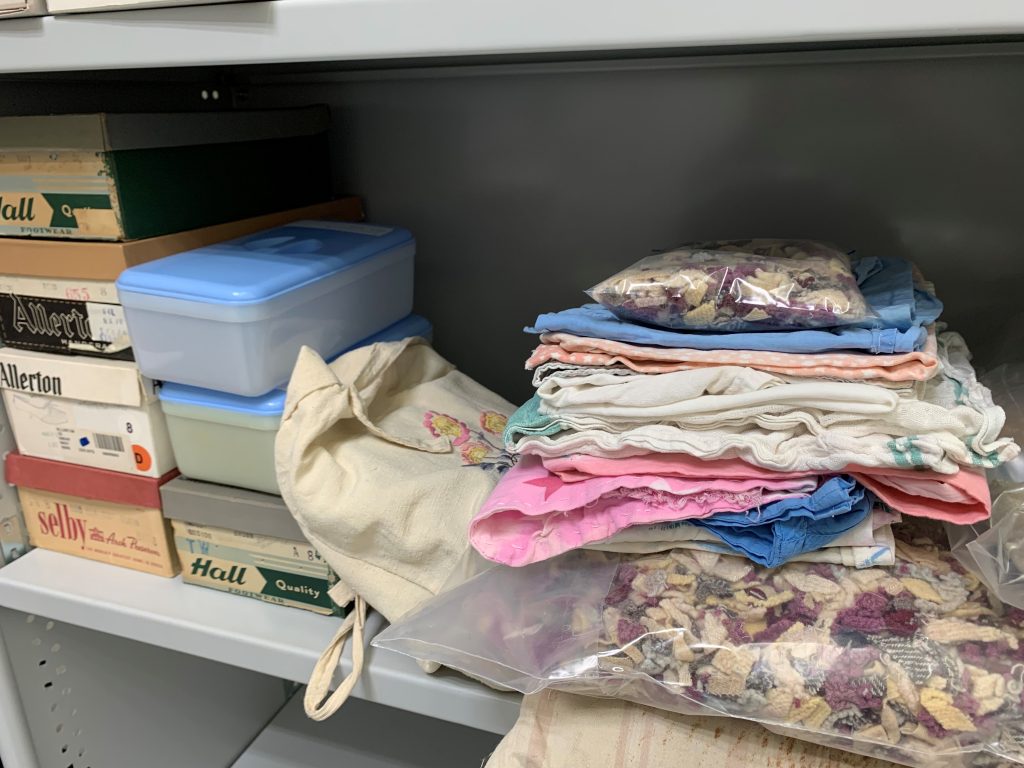
The collection contained, apart from manuscript and photographic material, a large component of textiles, handbags and shoes – items not generally expected in a standard manuscript collection. Delving deeper into its characters and stories, it became clear that these items were an integral part of the archive.
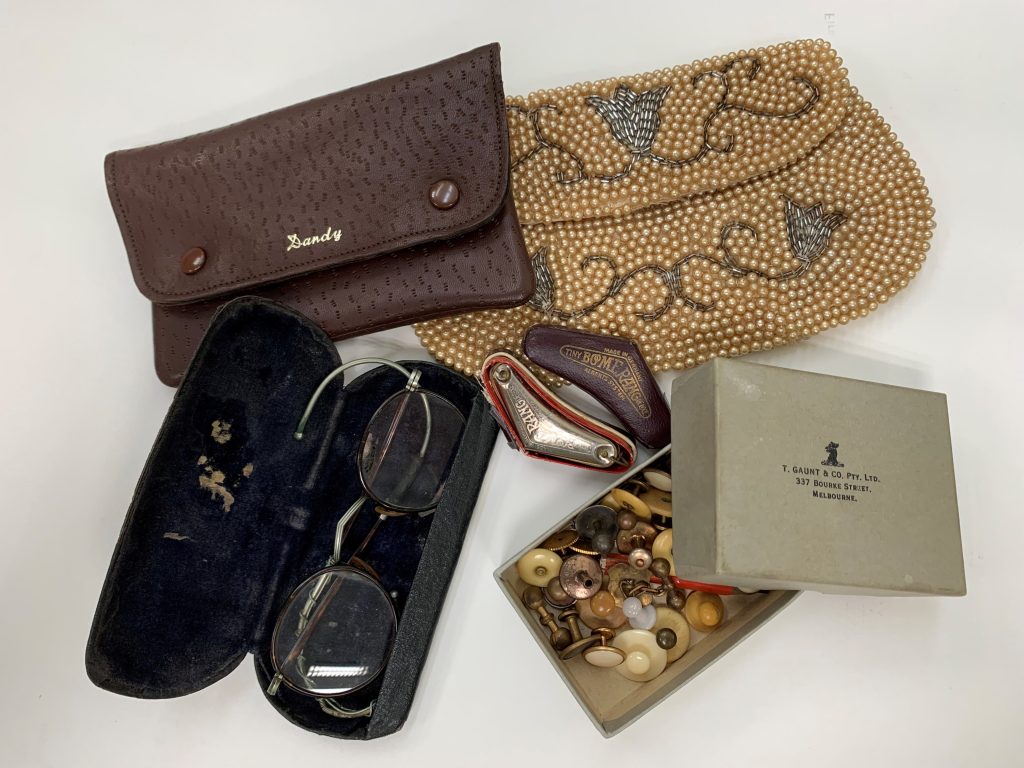
The manuscript component – correspondence, personal and business papers, books, receipts and ephemera – was relatively easy to rehouse. There were various non-standard items to preserve, such as commercial sewing patterns, coins and buttons – even bundles of hair – but the papers and photographs could undergo straightforward rehousing, labelling and listing.
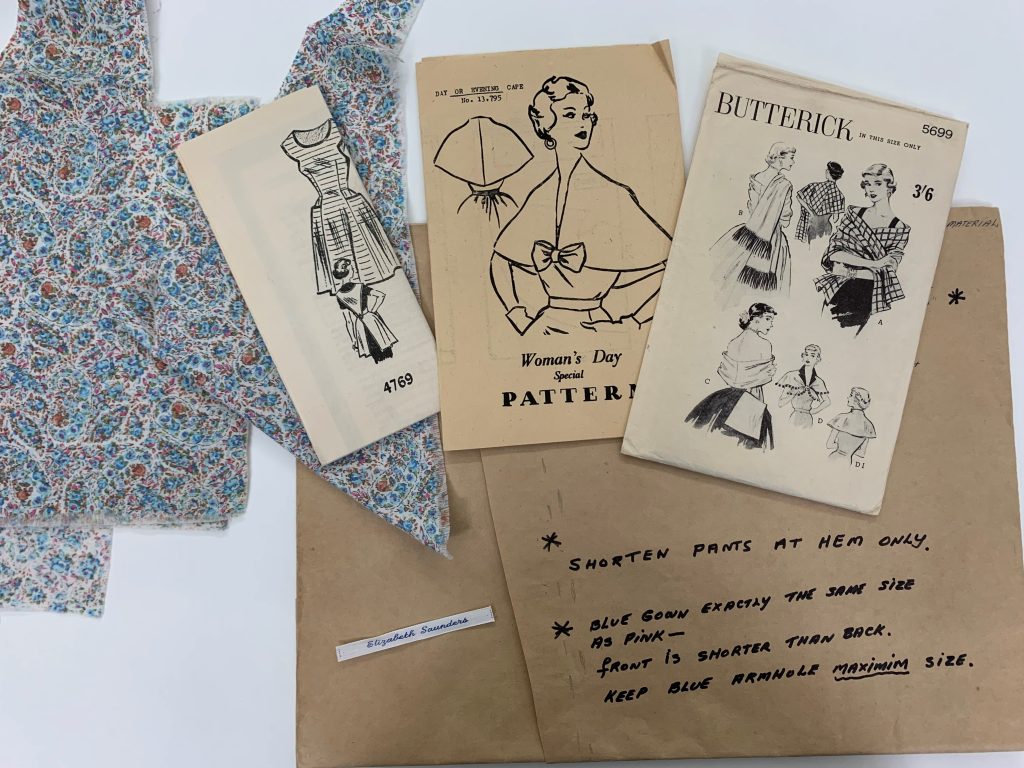
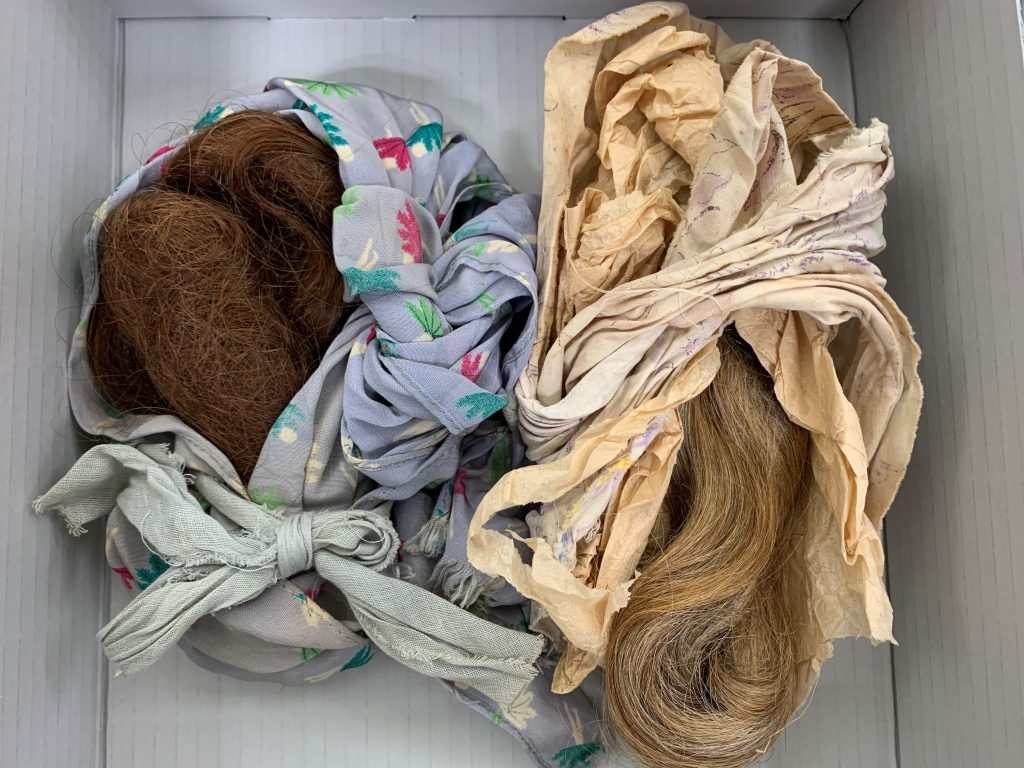
However, the sheer quantity and variety of textiles was, admittedly, a little daunting.
And why would the Library choose to preserve such a large collection of embroidered and crocheted tea towels and doilies, bedspreads, tablecloths, handkerchiefs and dresses, trousers, sleepwear, knitwear, lingerie and gloves?
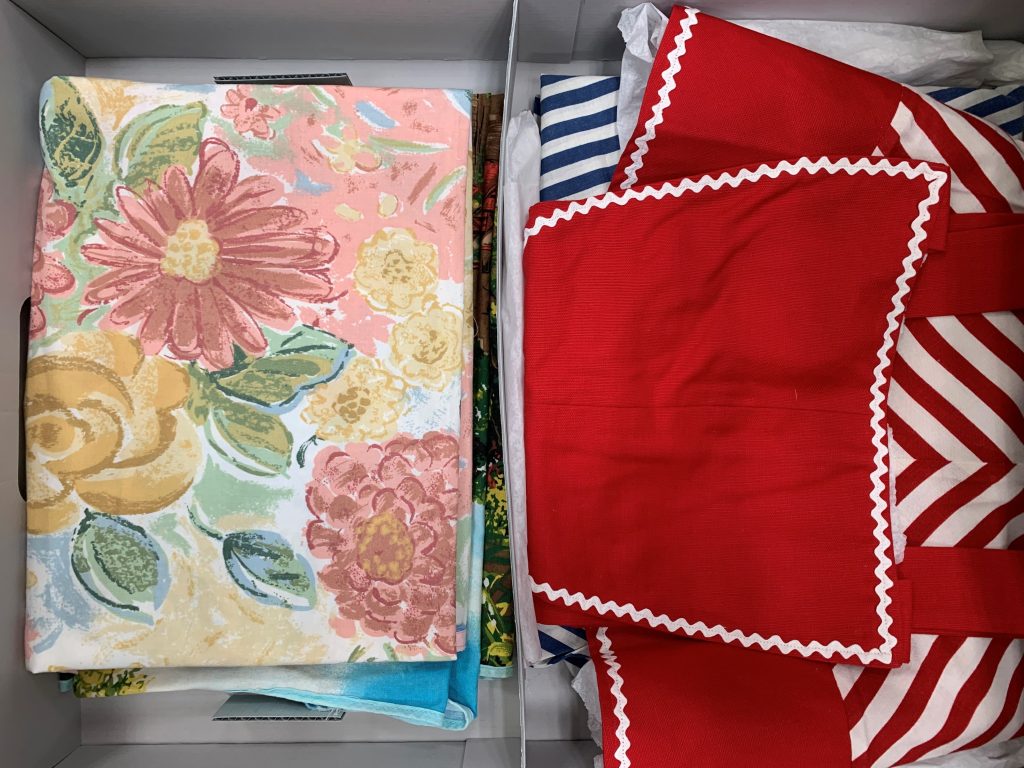
Family history
The Saunders family – James Farr Saunders, his wife Elizabeth Jane Taylor and their five children (one of whom died in infancy) – lived in Williamstown Road Port Melbourne, from 1929 until the auction of the house in 2016. By then, it was occupied only by Elizabeth Euphemia Saunders, their unmarried daughter.
The house was built as part of a pioneering low-cost housing estate scheme established, with government assistance, by the State Savings Bank.
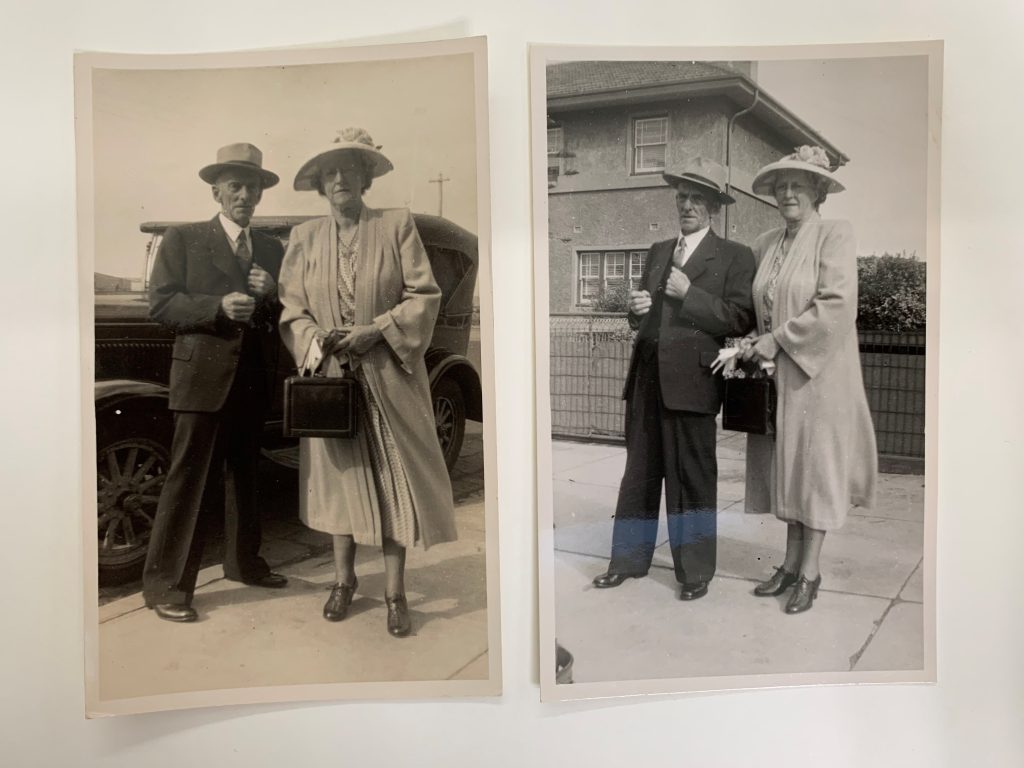
James worked full time as a wharfie. He was a member of the Port Phillip Stevedores Association and the Waterside Workers Federation of Australia. Elizabeth was an expert seamstress. She looked after their children, weathering the tough economic period by sewing, darning, re-sewing and re-darning every scrap they wore and used, not wanting to waste anything that could somehow be utilised.
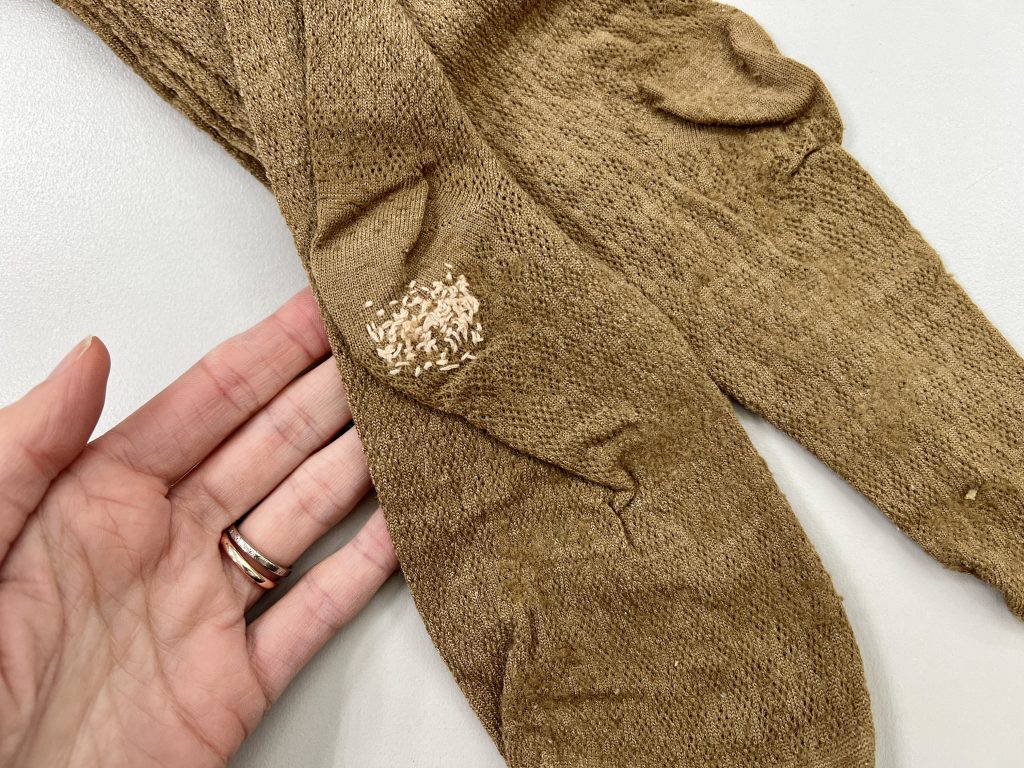
She made gowns and trousers, retaining every offcut. She made blankets from cut down jumpers and thermal underwear. She made tablecloths, placemats and handkerchiefs, embroidering them with flowers, and crocheted doilies and aprons.
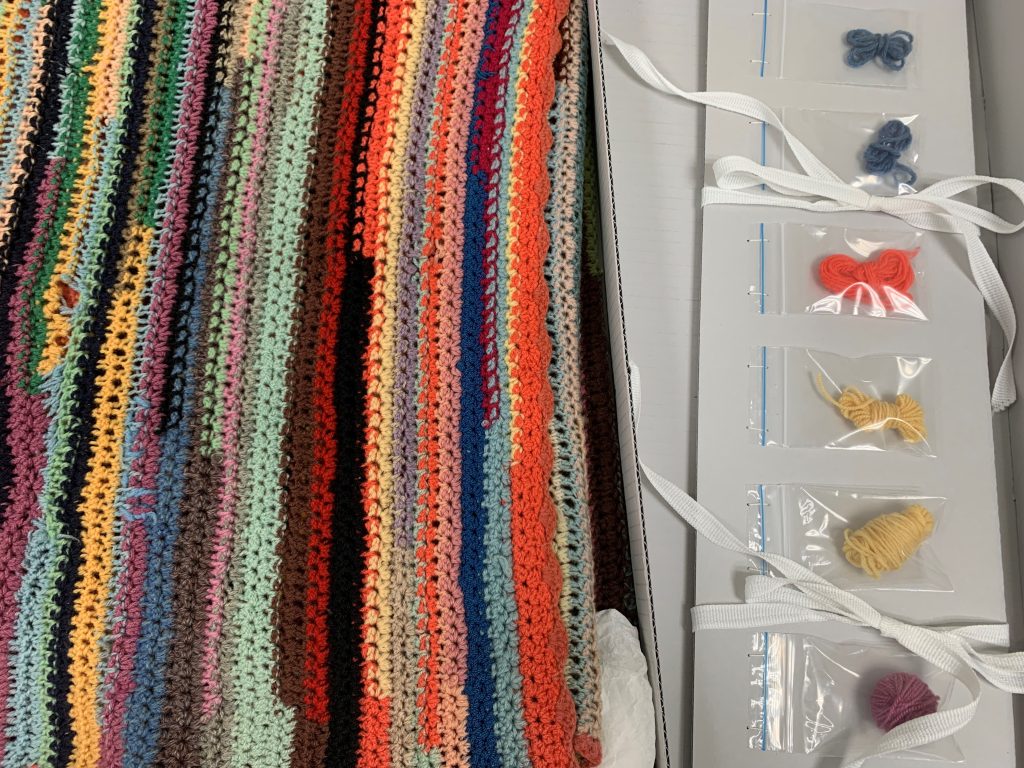
The family kept everything and, by the time Elizabeth Euphemia (‘Aunty Bet’) died in 2017, it had all been meticulously bagged and labelled, stored amongst the dust and detritus of a house, empty of inhabitants, but bursting with nearly 100 years of stories.
Aunty Bet left school at 13, to become a milliner’s assistant. She worked at Myer Emporium and then became a nursing aide for the Victorian School Dental Service, learning Italian and sign language to assist migrant and deaf children. With health issues surfacing, her relocation to a nursing home prompted family members to delve into the lives of their descendants, preserved within the cherished and well-used items left behind.

Items were donated to the Melbourne Museum, The National Trust and to the Better Hearing Archive. Much of what remained was relocated to the Library.
It’s cold in here!
Before they could be rehoused, the textiles went through the preventive process of blast freezing to remove the risk of active pest activity. Identifying potentially delectable woollen and silk items, it was important to ensure the complete life cycle of any pest was gently but comprehensively extinguished.
Over a number of months, bundles of clothing and haberdashery were carefully sealed and then frozen for up to four weeks. Items not suitable for freezing – such as leather and metals – were gently vacuumed or brushed as an alternate treatment.
After freezing, the packages were allowed to acclimatise, then checked for signs of pest activity. Gladly, there were none. We confidently moved forward into the sorting and rehousing stage.
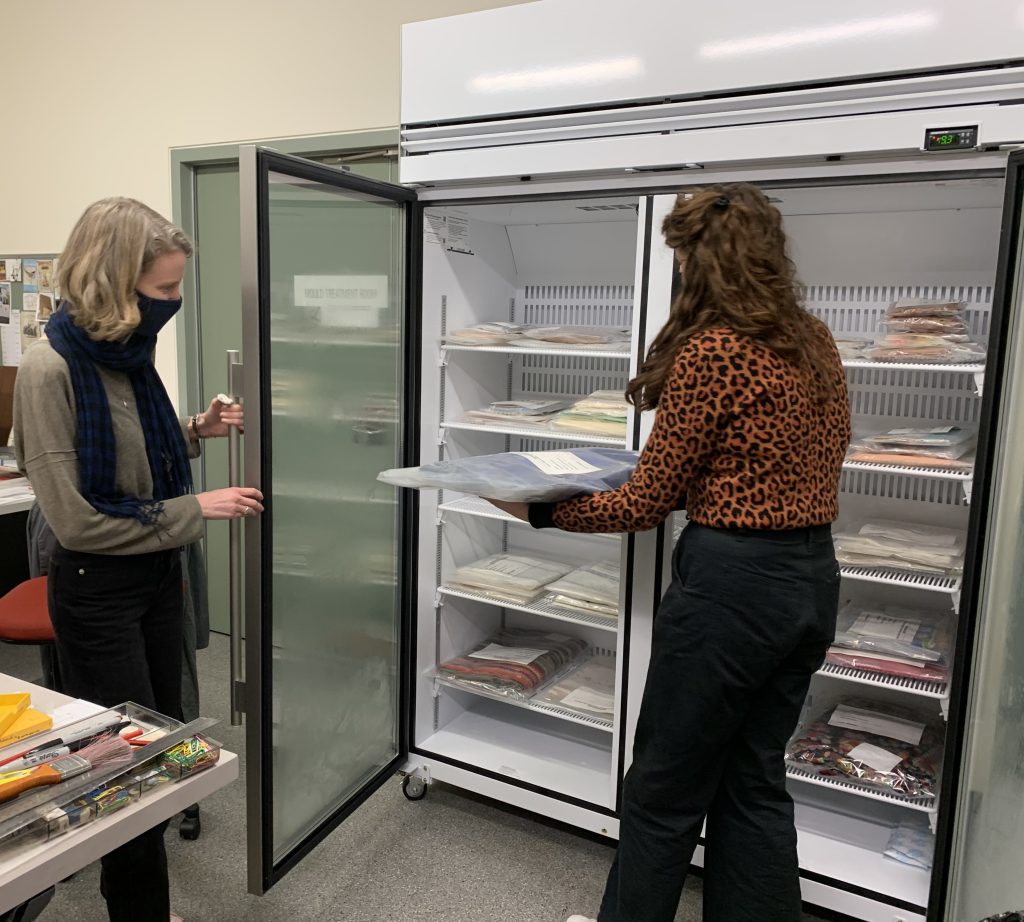
During this process, two scarves were discovered, smelling distinctly of acetic acid (think fish and chips), indicating the presence of deteriorating cellulose acetate. Due to the auto-catalytic nature of acetate (feeds off its own deterioration and actively affects adjacent materials), they have been rehoused separately in a well-ventilated enclosure to reduce the build-up of acetic acid and slow the deterioration down. Their condition will be checked and monitored over time.

Boxes and more boxes
Consideration of available storage space has determined the most effective way to package the textiles. Material has been grouped and layered in multiple shallow trays within boxes. Larger items, such as bedspreads, tablecloths, jackets and dresses have been carefully folded to reduce their footprint. It has been a time-consuming and delicate task to determine the appropriate arrangement of items, to measure each batch for custom boxes and to design supports that minimise internal movement.

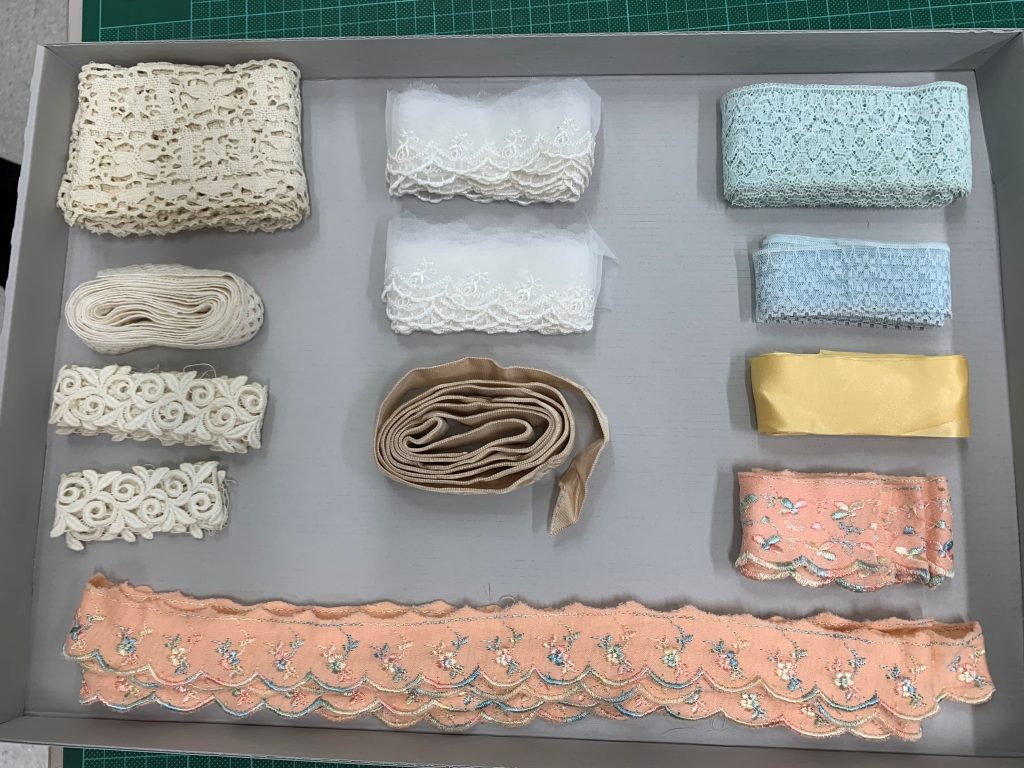
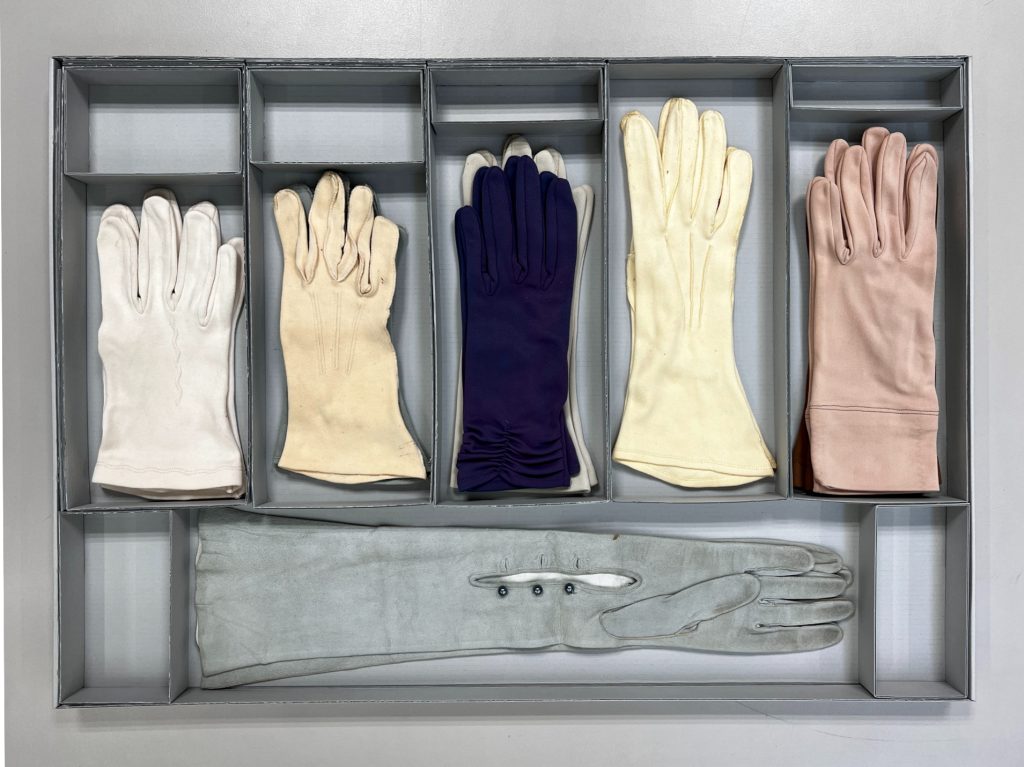
There is still much to do! Custom boxing of the textiles continues, along with the range of household objects – the buttons and coins, the jigsaw puzzles and game of scrabble, the sheet music, shaving kit and the sewing accessories – the thimbles, zips, buckles and knitting needles. And the cut-off pony tails that belonged to mother and grandmother.
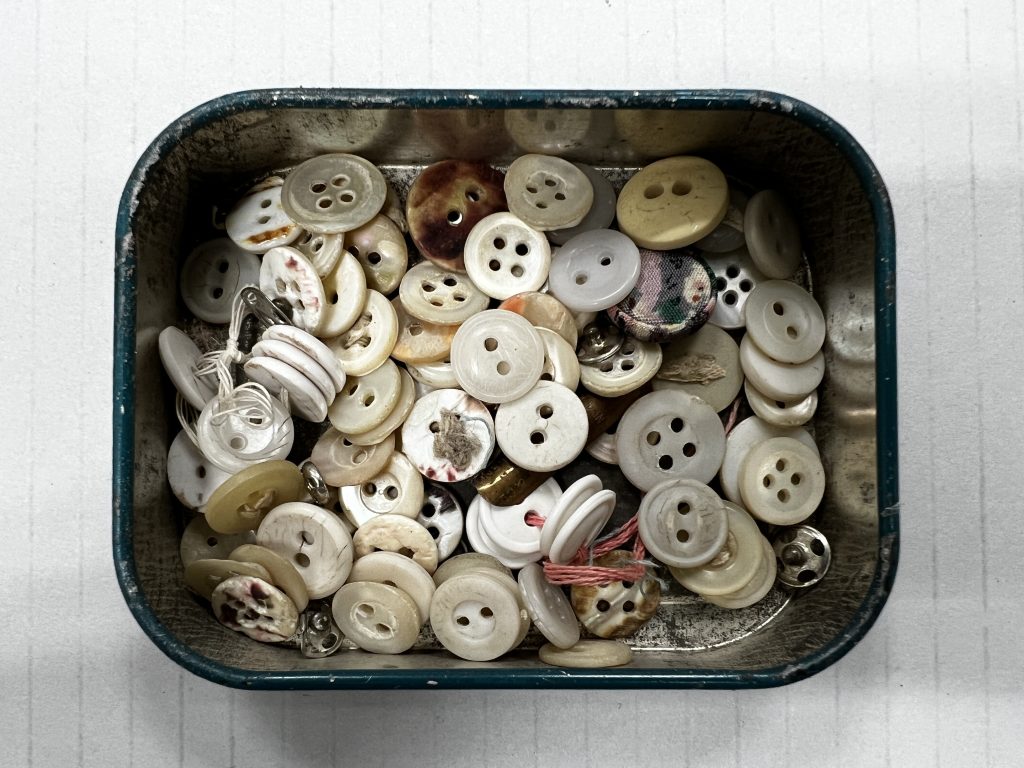

The collection is also being comprehensively listed; much valuable information was provided by University of Melbourne, which will become the basis of a catalogue record and research finding aid.
Already, the collection comprises over 50 boxes, larger than when it arrived. At first glance, the tightly packaged boxes, tins and folders offered little suggestion of what rested within.
When the sorting, rehousing and listing is finished, its contents will truly be revealed. This rich collection of papers, photographs, books, objects and, of course, textiles, will tell the generational story of an ordinary working-class Melbourne family, surviving economic depression, the influenza epidemic, the horrors of war and massive social, cultural and industrial changes.
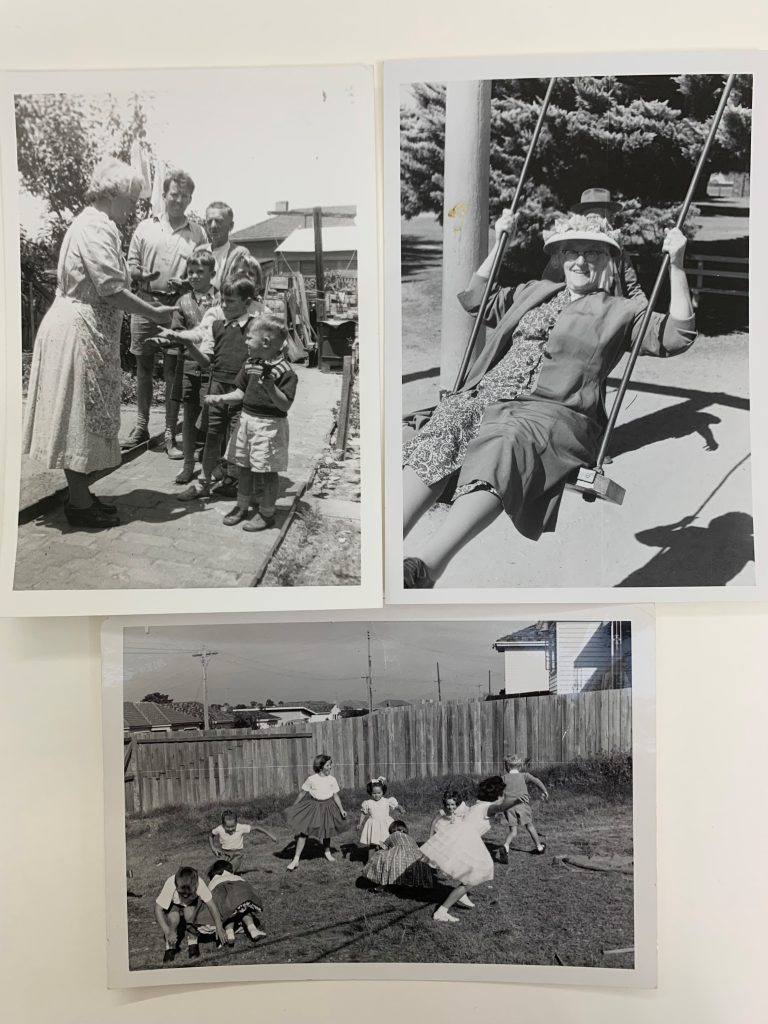
Big thanks to Preservation Technician Jessye Wdowin-McGregor and Paper Conservator Christine Mizzi for their careful work on this project.
References
Carlin, D, 2019, ‘The Historian’, Meanjin, Spring 2019, accessed on 3/05/2023, https://meanjin.com.au/essays/the-historian/
More to explore


What a beautiful collection, so glad there are these preservation and donations to help us remember the way our past generations lived in such tight times.
Thanks Belinda, I’m glad you like it. These amazing collections do allow us to reflect on the past.
With all the decluttering going on, and lots of everyday items going to landfill or op shops, how do we decide what everyday items are kept and stored for future generations to study and learn how we live our lives now ? Happy to pass on a lot of stuff from my life !!!!!!
Thanks Katy. It’s always hard to decide, we do seem to accumulate a lot! Keep what’s precious to you!
Oh what lovely treasure trove of a family’s life. The article was fascinating. Thank to all of your hard work in preserving such rich history.
Thanks Jenny – it has been a truly collaborative effort, with wonderful work done by Jessye and Christine in Collection Care. We think it’s an important history to preserve too!
This is so interesting thank you so much
Thanks Trish, I’m glad you enjoyed it.
Such wonderful social history. So many items which appear insignificant and of no value are discarded as the next generations come and go. It’s brilliant to have such a thorough time capsule of local everyday life.
Loved reading about the processes of preservation.
Keep up the marvellous and invaluable work!
Thanks so much Karen. It is a wonderful time capsule of very ordinary but cherished items. We’re thrilled to be able to preserve them all!
Thank you for sharing this wonderful story and collection about a working class family. Such an important part of our social history. It was so interesting to read about the preservation process.
Thanks so much Lynda. I’m glad you enjoyed it. It’s a wonderful story that we’re proud to share.
The collection looks amazing. How lucky to you were to open the boxes to find this amazing things of times gone by.
Thank you for sharing it
Sue Turner
Thanks so much Sue. We did feel lucky becoming custodians of this collection, it’s a special one.
How us Oldies love to look back on items we had seen at Grandmas and Nana’s houses. I am 83 years old and I have a crochet doily that belonged to my Nana . I am 1 of 5 girls in my family and not one of us crochet but our Beautiful Mother did and we all have beautiful articles in our cupboards. Sadly our Granddaughters are not interested in them. But thankfully there are some Craft Groups that are.
Hi Daphne – they must be precious items. I believe it was quite the generational activity in the Saunders family, perhaps brought on by necessity but also, I’m sure, a love of creating beautiful household items. Thanks so much for your thoughts.
A great reference point for future generations to reflect on the skills, effort and determination of a generation to make the best with what they had for those they loved. Wonderful to have for everyone to share.
Thanks Norma. There are certainly some learnings to take from this collection.
A great reference point for future generations to reflect on the skills, effort and determination of a generation to make the best with what they had for those they loved. Wonderful to have for everyone to share.
It was a collection that offered an enticing glimpse into the ordinary lives of a working-class family in Melbourne
Thanks for your comment.
Thank you for giving us the pleasure of reading this article and keeping these precious items.
Thanks so much Anne, I’m glad you’ve enjoyed it.
Hi Kate, Thank you for putting together this wonderful presentation. It brings back a lot of memories. I’m the youngest son of James Farr and Elizabeth Jane’s oldest son John Frederick Elliott. I’m the little boy in the family picture next to the one with Elizabeth Jane Saunders on the swing and currently aged 70. I would have been about 3 at the time of the picture so sadly, I have no memory of it being taken. But I have vivid memories of the house and its contents. Especially the fun we had bumping down and around the corners of the stairs on our bottoms and short sheeting Aunty Betty’s bed!
Hi Bruce – thanks so much for sharing those precious memories! I do love the family images, now made more special on learning of your connection. It’s always rewarding to make these collections discoverable and to receive such personal responses to our efforts. Much appreciated.
My mother lived through the Depression and always believed in preserving what could be reused. She was ahead of her time when it came to discarding useful items to landfill. She always had the box of ribbons etc. Consequently so do I. During Covid lockdowns when we couldn’t browse shops for small items eg 0.5m of trim, this ‘make-do’ concept was invaluable to me. I used my saved ribbon box constantly.
Thanks for the background on this wonderful story of preservation.
Thanks so much Carmel. We can definitely learn a lot from the stories and experiences within these collections. I appreciate your comments.
As an Historian I found this article fascinating. The minutiae of this family’s daily life, as evidenced by the artefacts, documents and photos they saved, tells us so much social history of the Saunders family, as a representative working-class one The SLV was lucky to receive this donation. The time span 1929-2016 was indeed a century of economic and social milestones (but the influenza epidemic occurred earlier). Are you able to follow up the father’s employment history during the Great Depression? And did anyone interview the last daughter? Her accompanying oral history would complete your collection. Well done SLV staff.
Hi Michele – thanks so much for your comments. The collection includes quite a substantial component of audio cassette recordings of Aunty Bet talking about her family. Hopefully as part of cataloguing and making the collection available, these recordings can be digitised and preserved. It would be interesting to use our extensive genealogical resources to dig deeper into their lives. Another blog perhaps?!
Looking at this was like looking into my Mother’s sewing box as a child. The fabrics told our history through dresses. I can still smell it and see the work or her hands. This is a beautiful record of women’s work and I’m so glad that the Library has preserved it with such loving care.
Thanks so much Janet for your thoughtful response. The physical objects in all their shapes and sizes do evoke powerful images of nurturing and caring for family and household. An important part of the archive.
Loved the collection and the history. It was like looking at our own. Our house has been in the family since 1930 and six generations have slept here. Various items have come and gone, but we treasure those we have kept. Thank you State Library for preserving this collection.
Thanks for your kind words, Fay. Those treasured items maintain a powerful connection to the past, which is important as we move so quickly towards the future.
Absolutely amazing. Thank you for all the hard work that you do to preserve so much that is often just dumped when family members pass on. You’ve given me hope that maybe some of my treasures may survive such a fate as I know there is no one who wants them.
Thanks so much Sophia. It is a difficult process for families, but personal treasures can hold such powerful memories.
I can tell by the number of comments how people are interested in such a collection. I am one of those people! As a tour guide at the SLV I think it’s such a shame that this wonderful archive is not available for our visitors to see. Is there any chance it will ever be on display? I know from experience how much visitors enjoy seeing things of this nature. When Changing Face of Victoria was operating it was the old, domestic items on display that attracted people.
I think the work you do in the Quarantine Lab is so impressive. I enjoy telling visitors about what happens behind the sliding door and now I can include the Saunders Family collection on my Dome to Catacombs tour.
Hi Isabel – thanks so much for your kind words. The world of Quarantine is a busy one and while it sometimes seems like a never-ending mix of dirty and pesty material, we are privileged to see some wonderful collections, such as the Saunders Family Archive. In relation to the display of items, there’s always a possibility!